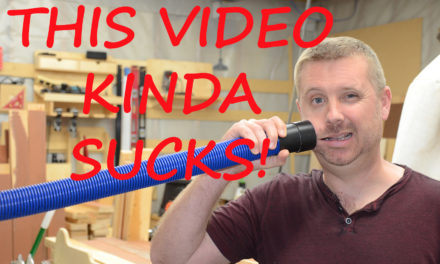Tools Needed
- Table Saw
- Planer (optional)
- Jointer (optional)
- Miter saw (optional)
- Parallel Clamps and/or Gear Clamps
As an Amazon Associate I earn from qualifying purchases. These links are tools and materials that I either use or have researched enough to recommend them.

Materials Needed
- Exterior wood glue like Titebond III
Ugly, Reclaimed Wood
Reclaimed wood has been quite popular for a number of years now. Everyone seems to like that old, distressed look. But what if you have access to some real ugly wood like old, stained, tongue and groove siding. Do you just throw it away? Today I’m going to show you how to transform this seemingly useless wood and turn it into nice boards like this that can be used for a project like this.
Why save that old wood?
A number of years ago, I had to remove this siding from my house because the wood used wasn’t suitable and the builder didn’t install it correctly anyways. I was too cheap to pay someone to haul it off so it’s been in my basement this whole time. Another reason I didn’t throw this siding away is because it’s cypress. Cypress is rot and insect resistant so it’s good for an outdoor project like a vegetable planter. Today I’ll show you what it took to go from here to here.
The Basic Steps
Upon inspection, I have a few things I need to accomplish with these boards.
- Remove the stain.
- Get rid of any knots that are too big or loose.
- Square up the boards because most of them are pretty twisted and warped.
After I solve all those problems, I’m very likely going to be left a board that is one half to five eighths inches thick. If that’s the case, it will be better to glue two boards together. Not only will this solve my thickness problem, but it will help straighten out some of these boards.
Initial Cuts and Sizing
So knowing that, let’s get started by first cutting out the real bad spots. Any knots that are completely gone or too large can be cut out. Split ends are also removed. This is also a good time to cut long boards down to a more manageable size. I won’t need any boards longer than 5 feet so I cut them accordingly. This is also a good time to check for nails. A metal detector is a cheap and effective way to find these and remove them before tearing up saw blades or worse yet, getting a nail flung at you.
Next, I remove the tongue and the groove. I do this right on the table saw. You’ll notice I’m not using a blade guard here. I removed it because the small slivers were getting caught in the guard and kicking back towards me. So now I just have to be extra careful.
Preparing Board Faces for Glue Up
The next step for me is a bit counter intuitive. I plane one face to remove the stain. Most woodworkers would start by jointing one face, but I’m not trying to get a square and straight board face. I just need a flat board face so I can glue two faces together. If you don’t have a planer, you can attempt to sand the faces with 40 or 60 grit sandpaper. You just need a flat face across the board. Don’t worry about boards that are curved or twisted along their length.
Now with all my boards ready to be glued. I can pair up boards of similar length and start the glue up.
Squaring Up the Edges & Final Thickness
After the glue up is complete, I now go to my jointer to get a mostly flat face and one straight edge. I’m not really careful here. I’m not trying to get a perfect 4 square board. I just need to be able to size these at the table saw using one straight edge. I’m taking a fairly deep cut on the edges to remove dried glue. After I have relatively straight edges, I go to the table saw and cut another straight edge on the other size and then I set my final board with, flip the board around and make the final rip cut. If you don’t have a jointer, stick around and I’ll show you how to do this with just a table saw.
The reason I did this before planing it to final thickness is because the stain and the glue really eat throw jointer and planer blades. So I want to minimize the face size that goes through the planer and I wanted to rely on the table saw as much as possible for squaring the edges. Finally, I run all the boards through the planer. I change sides each time I reduce the thickness. Once I get to 1” thick, I’m done.
The last step is to cut all the boards to length and then use them in our project.
Doing All This With Just a Table Saw
Now if you don’t have a jointer or planer, you’ll need to start by doing your best to align an edge of two boards when gluing up. Use a flat surface and make sure the boards don’t move as you apply clamp pressure. Once the glue is dried, use the table saw to cut straight edges and cut the board to final width. Then use the table saw to cut the thickness like this. Use shallow cuts and take some off one side and then the other. If your boards are very cupped or warped, I would not recommend using this method. It’s difficult to do this safely on those types of boards.
I had about 500-600 linear feet of this siding and I was able to make three of these elevated planters. I will admit, this is very time consuming. However, it was relatively cheap. It cost me about $100 because I had to replace my jointer and planer blades after this endeavor. It’s definitely worth it if you have plenty of time. These planters aren’t needed for another 4 months so I actually took my sweet time and dressed all the boards over a 10 week period.
So if you have some used boards, don’t throw ‘em away just yet. You might be able to reincarnate them as something more useful.








